Mormonism
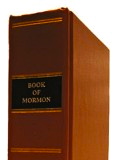
Search For Truth
What is Mormonism. This and many other questions are answered in this land mark and block buster film, “SEARCH FOR TRUTH. This is one of the best films ever made on the subject. Jesus Christ or Joseph Smith is the prominent theme that runs through the entire movie. The scarlet thread of eternal redemption is spun through out this very impressive Christian film. The lives of Jesus Christ and Joseph Smith are brought out on the open and exposed so that you may chose for yourself which is the way the truth and the life. Documents are uncovered and history is told leaving the cover bare. So, sit back and relax and be edified and instructed. The Bible has spoken, “choose.” (SEARCH FOR THE TRUTH) Thanks so very much for viewing this movie.
 Reprint of the first edition of the Book of Mormon (1830)
Reprint of the first edition of the Book of Mormon (1830)
Mormonism is the predominant religious tradition of the Latter Day Saint movement of Restorationist Christianity. This movement was founded by Joseph Smith, Jr., in the 1820s. During the 1830s and 1840’s, Mormonism gradually distinguished itself from traditional Protestantism. Mormonism today represents the new, non-Protestant faith taught by Smith in the 1840’s. After Smith’s death, most Mormons followed Brigham Young west, calling themselves The Church of Jesus Christ of Latter-day Saints (LDS Church). Other variations of Mormonism include Mormon fundamentalism, which seeks to maintain practices and doctrines such as polygamy that were abandoned by the LDS Church, and various other small independent denominations.
The word Mormon is derived from the Book of Mormon, one of the faith’s religious texts. Based on the name of that book, early followers of founder Joseph Smith, Jr. were called Mormons, and their faith was called Mormonism. The term was initially considered pejorative, but is no longer considered so by Mormons (although other terms such as Latter-day Saint, or LDS, are generally preferred).
Mormonism shares a common set of beliefs with the rest of the Latter Day Saint movement, including use of, and belief in, the Bible, as well as other religious texts including the Book of Mormon and Doctrine and Covenants. It also accepts the Pearl of Great Price as part of its scriptural canon, and has a history of teaching eternal marriage, eternal progression, and plural marriage, although the LDS Church formally abandoned the practice in 1891. Cultural Mormonismincludes a lifestyle promoted by the Mormon institutions, and includes cultural Mormons who identify with the culture, but not necessarily the theology.
History of the Latter Day Saint movement and History of The Church of Jesus Christ of Latter-day Saints
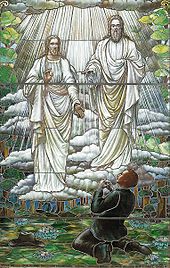 A stained glass window showing Joseph Smith‘s First Vision.
A stained glass window showing Joseph Smith‘s First Vision.
Mormonism originated in the 1820s in western New York during a period of religious excitement known as the Second Great Awakening. Founded by Joseph Smith, Jr., the faith drew its first converts while Smith was dictating the text of the Book of Mormon from Golden Plates he said he found buried after being directed to their location by an angel. The book described itself as a chronicle of early indigenous peoples of the Americas, portraying them as believing Israelites, who had a belief in Christ many hundred years before his birth. Smith dictated the book of 584 pages over a period of about three months saying that he translated it from an ancient language “by the gift and power of God.” During production of this work in mid-1829, Smith, his close associate Oliver Cowdery, and other early followers began baptizing new converts into a Christian primitivist church, formally organized in 1830 as the Church of Christ. Smith was seen by his followers as a modern-day prophet.
Smith later wrote that he had seen a vision of God the Father and Jesus Christ in spring 1820 in answer to his question of which denomination he should join. Sometimes called the “First Vision“, Smith’s vision of God the Father and Jesus Christ as two separate beings was reportedly the basis for the difference in doctrine between Mormonism’s view of the nature of God and that of orthodox Christianity. Smith further said that in answer to his prayer the Lord instructed him to join none of the existing churches because they were all wrong. During the 1820’s Smith reported having several angelic visitations, and by 1830 Smith said that he had been instructed that God would use him to re-establish the true Christian church and that the Book of Mormon would be the means of establishing correct doctrine for the restored church.
To avoid confrontation with New York residents, the members moved to Kirtland, Ohio and hoped to establish a permanent New Jerusalem or City of Zion in Jackson County, Missouri. However, they were expelled from Jackson County in 1833 and forced to flee Kirtland in early 1838. In Missouri, violent conflicts with other Missourians resulted in the governor of Missouri issuing an “extermination order,” expelling Latter Day Saints from Missouri. The displaced Mormons fled to Illinois and settled the city ofNauvoo, where they were able to live with a degree of peace and prosperity for a few years. However tensions between Mormons and non-Mormons again escalated to the point that in 1844, Smith was killed by a mob, precipitating a succession crisis. The largest group of Mormons, or The Church of Jesus Christ of Latter-day Saints, accepted Brigham Young as the new prophet/leader and emigrated to what became the Utah Territory. There, the church began the open practice of plural marriage, a form of polygyny which Smith had instituted in Nauvoo. Plural marriage became the faith’s most sensational characteristic during the 19th century, but vigorous opposition by the United States Congress threatened the church’s existence as a legal institution. In his 1890 Manifesto, church president Wilford Woodruff announced the official end of plural marriage.
Because of the formal abolition of plural marriage in 1890, several smaller groups of Mormons broke with the LDS Church forming several denominations of Mormon fundamentalism. Meanwhile, the LDS Church has become a proponent of monogamy and patriotism, has extended its reach internationally by a vigorous missionary program, and has grown in size to 14 million members. The church is becoming a part of the American and international mainstream. However, it consciously and intentionally retains its identity as a “peculiar people” set apart from the world by what it believes is its unique relationship with God.
Theology – Nature of God – God in Mormonism
Unlike most other Christian groups, Mormonism espouses a distinctly nontrinitarian theology as regards the nature of God. The LDS Church, the largest denomination within Mormonism, teaches that the Father, the Son, and the Holy Ghost are three separate and distinct beings, the Father and Son having perfected physical bodies and the Holy Ghost having only a body of spirit. While the three beings are physically distinct, in Mormon theology they are one in thoughts, actions, and purpose and commonly referred to collectively as “one God” or the “Godhead.” Also, Mormonism teaches that God the Father is the literal father of the spirits of all men and women, which existed prior to their mortal existence. Further, all humans as children of God can become exalted, inheriting all that God has, as joint-heirs with Christ, and becoming like him.
Restoration
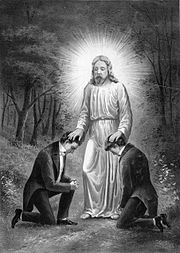 A depiction of Joseph Smith and Oliver Cowdery receiving priesthood authority from John the Baptist
A depiction of Joseph Smith and Oliver Cowdery receiving priesthood authority from John the Baptist
Restoration (Latter Day Saints)
Mormonism describes itself as falling within world Christianity, but as a distinct restored dispensation; it characterizes itself as the only true form of the Christian religion since the time of a Great Apostasy that began not long after the ascension of Jesus Christ. According to Mormons this Apostasy involved the corruption of the pure, original Christian doctrine with Greekand other philosophies, and followers dividing into different ideological groups. Additionally, Mormons claim the martyrdom of the Apostles led to the loss of Priesthood authority to administer the Church and its ordinances.
Mormons believe that God re-established the early Christian Church as found in the New Testament through Joseph Smith. In particular, Mormons believe that angels such as Peter, James, John, and John the Baptist appeared to Joseph Smith and others and bestowed various Priesthood authorities on them. Mormons thus believe that their Church is the “only true and living church” because divine authority was restored to it through Smith. In addition, Mormons believe that Smith and his legitimate successors are modern prophets who receive revelation from God to guide the church. They maintain that other religions have a portion of the truth and are guided by the light of Christ.
Cosmology
For many Mormons, Joseph Smith’s cosmology is the most attractive part of the restoration. Mormon cosmology presents a unique view of God and the universe, and places a high importance on human agency. In Mormonism, life on earth is just a short part of an eternal existence. Mormons believe that in the beginning all people existed as spirits or “intelligences,” in the presence of God. In this state, God proposed a plan of salvation whereby they could progress and “have a privilege to advance like himself.” The spirits were free to accept or reject this plan, and a “third” of them, led by Satan rejected it. The rest accepted the plan, coming to earth and receiving bodies with an understanding that they would experience sin and suffering.
In Mormonism, the central part of God’s plan is the atonement of Jesus Christ. Mormons believe that one purpose of earthly life is to learn to choose good over evil. In this process, people inevitably make mistakes, becoming unworthy to return to the presence of God. Mormons believe that Jesus paid for the sins of the world, and that all people can be saved through his atonement. Mormons accept Christ’s atonement through faith, repentance, formal covenants or ordinances such as baptism, and consistently trying to live a Christ-like life.
Ordinances
In Mormonism, an ordinance is a religious ritual of special significance, often involving the formation of a covenant with God. Ordinances are performed by the authority of the priesthood and in the name of Jesus Christ. The term has a meaning roughly similar to that of the term “sacrament” in other Christian denominations.
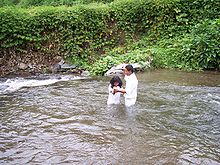 An eight-year-old girl being baptized in Cerro Punta, Panama
An eight-year-old girl being baptized in Cerro Punta, Panama
Saving ordinances (or ordinances viewed as necessary for salvation) include: baptism byimmersion after the age of accountability (normally age 8); confirmation and reception of the gift of the Holy Ghost, performed by laying hands on the head of a newly baptized member; ordination to the Aaronic and Melchizedek priesthoods for males; an endowment(including washing and anointing) received in temples; and marriage (or sealing) to a spouse.
Mormons also perform other ordinances, which include the Lord’s supper (commonly called the sacrament), naming and blessing children, giving priesthood blessings and patriarchal blessings, anointing and blessing the sick, participating in prayer circles, and setting apart individuals who are called to church positions.
In Mormonism, the saving ordinances are seen as necessary for salvation, but they are not sufficient in and of themselves. For example, baptism is required for exaltation, but simply having been baptized does not guarantee any eternal reward. The baptized person is expected to be obedient to God’s commandments, to repent of any sinful conduct subsequent to baptism, and to receive the other saving ordinances.
Because Mormons believe that everyone must receive certain ordinances to be saved, Mormons perform ordinances on behalf of deceased persons. These ordinances are performed vicariously or by “proxy” on behalf of the dead. In accordance with their belief in each individual’s “free agency”, living or dead, Mormons believe that the deceased may accept or reject the offered ordinance in the spirit world, just as all spirits decided to accept or reject God’s plan originally. In addition, these “conditional” ordinances on behalf of the dead are performed only when a deceased person’s genealogical information has been submitted to a temple and correctly processed there before the ordinance ritual is performed. Only ordinances for salvation are performed on behalf of deceased persons.See also: Baptism for the dead.
Scripture
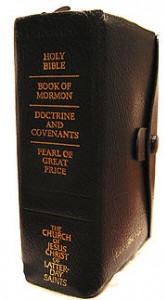 The LDS Church scriptural canon
The LDS Church scriptural canon
Mormons believe in the Old and New Testaments, and the LDS Church uses the King James Bible as its official scriptural text of the Bible. While Mormons believe in the general accuracy of the modern day text of the Bible, they also believe that it is incomplete and that errors have been introduced. In Mormon theology, many lost truths are restored in the Book of Mormon, which Mormons hold to be divine scripture and equal in authority to the Bible.
The Mormon scriptural canon also includes a collection of revelations and writings contained in the Doctrine and Covenants and the Pearl of Great Price. These books, as well as the Joseph Smith Translation of the Bible, have varying degrees of acceptance as divine scripture among different denominations of the Latter Day Saint movement.
Revelation
In Mormonism, continuous revelation is the principle that God or his divine agents still continue to communicate to mankind. This communication can be manifest in many ways: influences of the Holy Ghost (the principal form in which this principle is manifest), visions, visitations of divine beings, and others. Joseph Smith used the example of the Lord’s revelations to Moses in Deuteronomy to explain the importance of continuous revelation.
“God said, ‘Thou shalt not murder’ at another time He said, ‘Thou shalt utterly destroy.’ This is the principle on which the government of heaven is conducted–by revelation adapted to the circumstances in which the children of the kingdom are placed. Whatever God commands is right, no matter what it is, although we may not see the reason thereof till long after the events transpire.”
—Joseph Smith, Teachings of the Prophet Joseph Smith, pp. 256–257.
Mormons believe that Smith and subsequent church leaders could speak scripture “when moved upon by the Holy Ghost.” In addition, many Mormons believe that ancient prophets in other regions of the world received revelations that resulted in additional scriptures that have been lost and may, one day, be forthcoming. In Mormonism, revelation isn’t limited to church members alone. For instance, Latter Day Saints believe that the United States Constitution is a divinely inspired document.
Mormons are encouraged to develop a personal relationship with the Holy Ghost and receive personal revelation for their own direction and that of their family. The Latter Day Saint concept of revelation includes the belief that revelation from God is available to all those who earnestly seek it with the intent of doing good. It also teaches that everyone is entitled to personal revelation with respect to his or her stewardship (leadership responsibility). Thus, parents may receive inspiration from God in raising their families, individuals can receive divine inspiration to help them meet personal challenges, church officers may receive revelation for those whom they serve.
The important consequence of this is that each person may receive confirmation that particular doctrines taught by a prophet are true, as well as gain divine insight in using those truths for their own benefit and eternal progress. In the church, personal revelation is expected and encouraged, and many converts believe that personal revelation from God was instrumental in their conversion.

